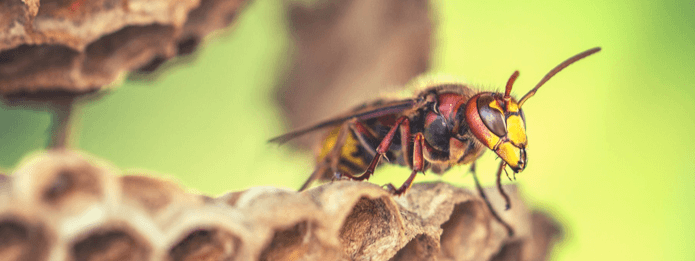 How many different species of wasps do you think there are? You might only identify them as wasps whose stings hurt, and the other wasps whose stings hurt an awful lot more. Scientists believe there are around 30,000 different species of wasp – and that’s only the ones they’ve managed to identify so far. So of the 30,000 different species of wasps, are they all dangerous? Do they all sting us, ruin our dinner parties and terrorize picnics?
Thankfully, the answer to that question is no. In fact, some species of wasp are so human-shy that you won’t even know they exist and won’t need wasp control to combat. It is difficult to tell the difference between certain wasp species – especially if you’re feeling the site in fear – but it’s good to know about the different variety of wasps that could be in your backyard. In this article, we’re going to look at a lesser-known type of wasp: predatory wasps. We’ll look a little closer at their behavior and why you might not be too unhappy to find them on your property.
How many different species of wasps do you think there are? You might only identify them as wasps whose stings hurt, and the other wasps whose stings hurt an awful lot more. Scientists believe there are around 30,000 different species of wasp – and that’s only the ones they’ve managed to identify so far. So of the 30,000 different species of wasps, are they all dangerous? Do they all sting us, ruin our dinner parties and terrorize picnics?
Thankfully, the answer to that question is no. In fact, some species of wasp are so human-shy that you won’t even know they exist and won’t need wasp control to combat. It is difficult to tell the difference between certain wasp species – especially if you’re feeling the site in fear – but it’s good to know about the different variety of wasps that could be in your backyard. In this article, we’re going to look at a lesser-known type of wasp: predatory wasps. We’ll look a little closer at their behavior and why you might not be too unhappy to find them on your property.
 How many different species of wasps do you think there are? You might only identify them as wasps whose stings hurt, and the other wasps whose stings hurt an awful lot more. Scientists believe there are around 30,000 different species of wasp – and that’s only the ones they’ve managed to identify so far. So of the 30,000 different species of wasps, are they all dangerous? Do they all sting us, ruin our dinner parties and terrorize picnics?
Thankfully, the answer to that question is no. In fact, some species of wasp are so human-shy that you won’t even know they exist and won’t need wasp control to combat. It is difficult to tell the difference between certain wasp species – especially if you’re feeling the site in fear – but it’s good to know about the different variety of wasps that could be in your backyard. In this article, we’re going to look at a lesser-known type of wasp: predatory wasps. We’ll look a little closer at their behavior and why you might not be too unhappy to find them on your property.
How many different species of wasps do you think there are? You might only identify them as wasps whose stings hurt, and the other wasps whose stings hurt an awful lot more. Scientists believe there are around 30,000 different species of wasp – and that’s only the ones they’ve managed to identify so far. So of the 30,000 different species of wasps, are they all dangerous? Do they all sting us, ruin our dinner parties and terrorize picnics?
Thankfully, the answer to that question is no. In fact, some species of wasp are so human-shy that you won’t even know they exist and won’t need wasp control to combat. It is difficult to tell the difference between certain wasp species – especially if you’re feeling the site in fear – but it’s good to know about the different variety of wasps that could be in your backyard. In this article, we’re going to look at a lesser-known type of wasp: predatory wasps. We’ll look a little closer at their behavior and why you might not be too unhappy to find them on your property.

